Smoke

© Tony Smith Estate / Artists Rights Society (ARS), New York

© Tony Smith Estate / Artists Rights Society (ARS), New York

© Tony Smith Estate / Artists Rights Society (ARS), New York

© Tony Smith Estate / Artists Rights Society (ARS), New York

© Tony Smith Estate / Artists Rights Society (ARS), New York

© Tony Smith Estate / Artists Rights Society (ARS), New York

© Tony Smith Estate / Artists Rights Society (ARS), New York
Please log in to add this item to your gallery.
View comments
No comments have been posted yet.
Add a comment
Please log in to add comments.
Please log in to add tags.
* Nearly 20,000 images of artworks the museum believes to be in the public domain are available to download on this site.
Other images may be protected by copyright and other intellectual property rights.
By using any of these images you agree to LACMA's Terms of Use.
Smoke
Edition: 1/3
1967, fabricated 2005Sculpture; stands
Painted aluminum
Installation: 290 × 564 × 396 in.
Weight: 7 Ton 700 lb. (6667.9 kg)
Made possible by The Belldegrun Family’s gift to LACMA in honor of Rebecka Belldegrun’s birthday (M.2010.49.1-.66)
Not currently on public view